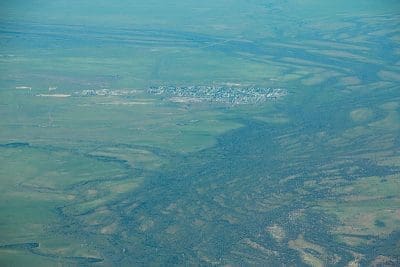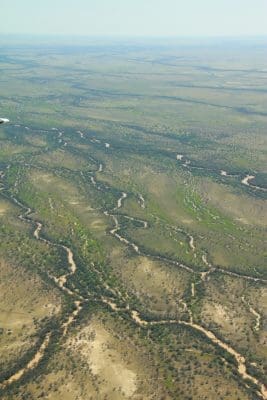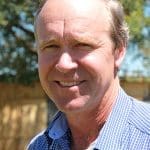Western Queensland from the air is a blanket of green and sunlight glinting off stockwater dams that until recently brimmed only with dust.
It is a picture that suggests a rapid cattle herd rebuild may soon be underway, but on the ground that is not quite the case.
For one, while the seasonal position is clearly much improved for many, it is still too early to declare drought conditions broken, according to Longreach mayor Ed Warren.
“We have a lot of good solid herbage feed, but we still haven’t got grass,” he told Beef Central during a two-day flying visit to Cloncurry, Longreach, Quilpie and Roma last week.
“The next process is to get some summer rain to get some grass growing.”
The high cost of replacement females is also stifling the cattle herd recovery process.
Restocking ‘nervously’
Some producers are trucking in females bought from areas such as Charters Towers, but they are restocking ‘nervously’, says Longreach sheep and cattle producer and AgForce representative Dominic Burden.
Breeding females currently cost about $1650 for PTIC cows or $1100 for empty heifers.
Consider that to generate a return from $1100 empty heifers it will take another three or so months to get them up to joining weight, another nine months in calf, and another 12 months or so until the progeny could be sold.
“That’s why they’re nervous,” Mr Burden said.
“This is a restocking exercise, it is not a money making exercise.”
Going back to sheep
There is also talk in more traditional sheep growing areas such as Longreach and Quilpie of properties that had moved from sheep to cattle a decade or so ago returning to sheep, due to the lower replacement cost and faster return, through either wool growing Merinos or fleece-shedding meat-breeds.
Helping this process are Government subsidies for dog-proof netting fences, which are giving producers renewed confidence to restock with sheep, in the knowledge the dog threat can be finally managed.
“The big rush is to get the fences up so people can go back to sheep,” Longreach producer Rosemary Champion said.
“I think there will be a lot of meat sheep coming back into the district.”
Drought impact
The impact of the severe run of dry years is reflected in Longreach mayor Ed Warren’s estimate that the shire is currently 90 percent destocked.
Rosemary Champion and her husband Warwick made a decision to keep their breeding herd intact during the long-running drought, selling machinery and equipment off to buy feed.
They have now emerged with 120 breeders, which may now be one of the largest breeding herds in the entire Longreach district.
‘It has just been a heartache’
“It has just been a heartache,” Mrs Champion said.
“We have been breeding for 54 years and we wanted to hang onto our precious base.
“We sold machinery and bought hay at great cost.
“It has proved pretty right because the calves from those breeders brought nearly $1200 on AuctionsPlus.
“There are not enough of them, but still we have the nucleus.”
The Champions are hoping to return to their usual numbers of 450 breeders, and may soon sell young weaners to buy more cows, but the cost of breeders and finance stands as a serious barrier.
The lack of a guaranteed season is also a factor.
“We have to be prepared to wait, we don’t have our perennials up yet,” Mrs Champion said.
“The Buffel and Mitchell grass has been very slow to come through. It has been a cold and wet winter, and it is coming from a base of nothing.”
Another concern is the noxious native weed pimelea which has emerged across thousands of hectares during the recent long-running drought, which could also disrupt restocking intentions, Mrs Champion predicted.
Agistment rates dropping
Agistment rates in the district have reportedly dropped quite significantly from several dollars per head per week down to below $3 per head per week (anecdotally) as producers unable to restock try to attract agistment stock to generate an income.
It is understood more active restocking has been occurring in the Winton and McKinlay regions, which received an earlier break than Longreach, but the high price of cattle remains an issue for many producers.
Mayor Ed Warren said cattle are only just starting to return to the Longreach area. While the cost was high to buy, he predicted more would come in through agistment.
“The price of stock is quite expensive so they are limited in their financial capacity to buy.
“But there are other opportunities, there are people with country to pasture stock.
“In the mid-80s, we had 50,000 cattle come in from the NT and Kimberley.”
Record September rain at Quilpie
In the State’s south west at Quilpie, record September rainfall has kick started a long-awaited and seemingly promising seasonal recovery.
Rainfall records on mayor Stuart McKenzie’s Eromanga district property Plevna Downs go back as far as 1880.
Until this year, the most rain ever received in September on the property was 70mm.
That was until September this year, when the McKenzies tipped 100mm out of their gauge last month.
Cattle and sheep numbers in the district suffered severely during the drought from 2001 to 2009. They had recovered to about 70pc of long-term numbers by 2012, only to be again decimated by the most recent drought.
Cattle numbers are now back to below 40pc of long-term stocking levels, Cr McKenzie believes.
With five new property clusters now fenced to netting, more producers were restocking with sheep, he said.
“More producers are talking about it now, they can’t afford to buy in the cattle,” Cr McKenzie said.
“The last three to four years has brought home to a lot of people who transitioned to cattle that it is tough when it gets dry.”
The trend seems likely to continue, with Cr McKenzie predicting most properties in the district will have dog exclusion fencing within 10 years.
Hughenden misses the break
While many areas are now blanketed in green for the first time in years, not all have had the vital break.
Hughenden cattle producer Rob Atkinson has received just 270mm so far this year, well below the 600mm received around Longreach.
He said a “fair lump of country” in his district involving as many as 80 properties was still yet to get desperately needed rain.
The Atkinsons are only carrying about 30pc of what they would consider to be normal numbers.
“We have some preg tested empty cows which is all we have had to sell,” he said.
“We normally would be selling grassfed bullocks, but the oldest steer we have got is just sucking mum.
“We have lost two calf crops, plus our breeder numbers have been decimated.”




